Raspberry Pi - RS Components Interview
We caught up with Pete Woods from suppliers of the Raspberry Pi to find out just what this credit-card computer can do, and why we all need one.
Listen to FrequencyCast Show 91 - Raspberry Pi Interview |
A Slice of Pi:
Part of our transcript from FrequencyCast Show 91, where we find out about this micro-computer board:
Transcript continues from o2 TU Go Review
Pete:
Fair enough. Instead of being something feline and canine-based, shall we talk about some fruit now?
Kelly:
Oh, let's!
Pete:
And what's your favourite fruit?
Kelly:
Raspberries.
Pete:
Well done! So what shall we talk about?
Kelly:
The Raspberry Pi?
Pete:
You knew that was coming, didn't you? – because on my desk, you can see one of those – go on. Grab hold of that.
Kelly:
 I can. Here is my little Raspberry Pi.
I can. Here is my little Raspberry Pi.
Pete:
And we have been challenged to build something with this Raspberry Pi. A couple of shows ago, we didn't quite get round to it last month, but it is very much on our to-do list, and I have a little case for you – this is to get you started with your project. A transparent case, cost about £4 on Amazon – can you put our office Raspberry Pi in this case?
Kelly:
I can certainly try.
Pete:
Oh, look at you! – didn't even break a nail.
Kelly:
I know! I'm quite impressed, actually ... but I can't get the lid on.
Pete:
It's in – look at that. So here we've got your Ethernet connector, your two USB connectors, your power connector, and your HDMI connector, all sticking out of the box. So there you go – for £4, you can neatly box your Raspberry Pi, which is better than what I used to do, which was Blu-Tack it on the side of my desk.
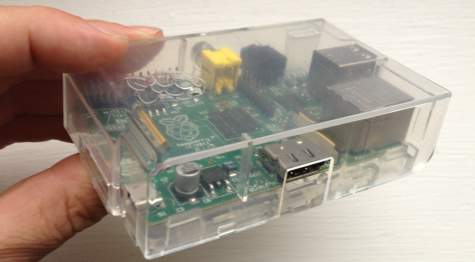
So, I was rather fortunate – I was at Bletchley Park. What happened at Bletchley Park?
Kelly:
It's the home of the codebreakers.
Pete:
And I was there in July with the amateur radio boys, seeing what they were up to. There, I bumped into Pete Wood, a lovely chap from RS Components, one of the leading suppliers in the UK of the Raspberry Pi, and he told me just what this tiny computer is all about, and why every home needs one .
Pete W:
Well, the Raspberry Pi is a fantastic piece of kit. It was designed to address a lost generation of computer programmers, hardware guys; pretty much the PlayStation generation we have today, who didn't get access, like I did in the Eighties, to Commodore 64s and Sinclair Spectrums, going down the newsagent's, getting your magazine, typing in the code for hours, trying to run a game, knees on the carpet, for hours and hours on end. The kids today have lost all of that. They know how to use tech – they don't understand how it works. So the reason why the Raspberry Pi was developed is because Eben Upton, one of the guys who invented it, saw that there was this massive decline in computer science graduates, hardware engineers, etcetera. It really concerned him – we don't want to lose the engineers that we have today for a next generation. We're going to lose all our engineers, and they'll all go overseas, so the Raspberry Pi was developed for them to learn programming from the outset.
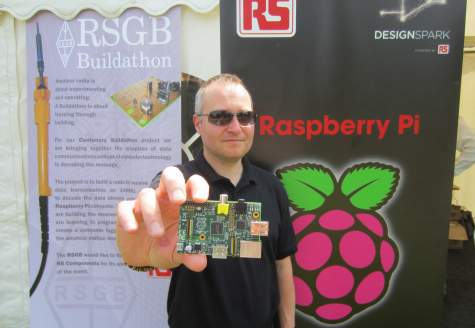
What's been really cool about the Raspberry Pi is, because it's such a low-cost, cheap piece of kit, the hacker community, or the techs, the geeks, all the guys have picked up on it, and they've started creating all kinds of brilliant little projects. They're writing code to control little bits of hardware add-on boards that they've designed, whether it be something, anything simple from a kind of digital signage application; to controlling your broken garage door opener, and opening it with your mobile phone; running an Xbox media centre platform, again controlled with your mobile phone, so you can watch all your movies for a fraction of the cost of your Apple solution. But there's so many things out there that people are doing. I run a Raspberry Jam over at Oxford. There's a network of Raspberry Jams, which is basically a geek-up, where people get together, bring all the tech that they've designed using their Raspberry Pis, show it all off, share what they've learnt, teach other people how they've done the actual stuff, and it's a really great community spirit of that.
When I first hooked up with Eben Upton over at the Foundation, he thought that we'd sell about 10,000 boards, and I think to date there are over a million now. It's just been absolutely incredible, the adoption rate, and we can't build these things fast enough. So I just think it's a great way for kids today to learn about technology at a grass roots level, put down the PlayStations, pick up a keyboard and a mouse, start coding, and there's so much information out on the internet, and it's just a great way for kids to learn about technology.
Pete:
Absolutely, I fully agree with that. I was one of the very early ones on the waiting list, when they very first came out – the old A and the Bs, I think it was then. What are the spec of these things now? – because I know they've got a recent addition, haven't they?
Pete W:
There's actually two models. They first came out with a Model B, and it's an ARM11 processor. It's a 700 MHz processor. You can overclock them to about a gig. I've done it myself, they do get a little bit warm. The original Pi came out with, the Model B, a 35-dollar computer, as it was coined, then they bought out the Model A, which is the cut-down version. It basically loses the Ethernet connection, brings the power consumption right down, so if you're doing a remote application that's running from a battery, etcetera, you can save so much more power, and get much more life out of your battery. It's amazing – for 700 MHz processing power, with I think it's half a gig of RAM on there now, and of course the SD card is like your hard drive – I think I've known people use that up to about 64GB.
The actual OS itself takes about two, so you've got all that space to add your videos and anything that you're doing, or you can hook these things up to NAS drives, or whatever you want to do. The spec is pretty impressive. We were running some HD video back there on the XBMC player – it was really smooth, there's no jitter. The audio's incredible. We've also got Minecraft running on one of the other ones – it runs really well. There's people who are building bit coin miners – it probably struggles a bit, to do some of that. It's a really versatile piece of kit, and for the price, the great thing is, you buy one to do one thing, and rather than take it to pieces, and do something else, you just buy another Pi, and start building a kit. I've got about ten Pis myself at the minute, I think.
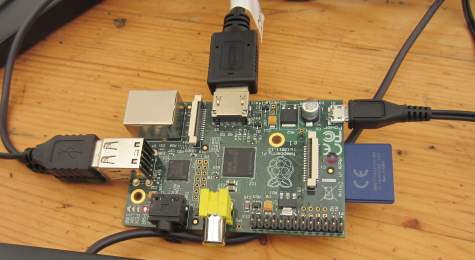
Pete:
And of course, that's what's not really coming across here on the radio, is (a) the size, and (b) the price. So can you just give us a physical description of a Pi?
Pete W:
So the Pi is a credit card-sized computer, so it's got the GPIO pins that give you access to the processor, and you've also got your HDMI connector for your telly, and the audio connections for analogue and video as well, if you want to use those. There's a couple of USBs on there, and there's obviously the Ethernet port as well, so it's really, really small. There's a massive industry up there for boxes, people making boxes for them. You can stick them behind your telly – I've Velcroed mine to the back of my telly, for my XBMC. They'll fit in your pocket basically – they're a pocket-size computer, and the great thing about them is that you can take them anywhere. You don't have to lug it around. If you've got a little small keyboard, with a little mouse tracker, and your power supply, and off you go. You can stick it in your bag, say.
Pete:
Well, you can certainly give me a helping hand here, because in the last show, we featured a listener's email, where they were asking us to try and build our own PVR, one of these recording bits of kit, and it can be done, and it can be done very cheaply. Now, I've got the Pi; I've got the Bluetooth keyboard and the mouse, and I can connect it up to my telly via HDMI. What do I need to get this PVR going, then?
Pete W:
You would need to get yourself probably one of the distributions – I'm sure there's probably a version of XBMC. I've got one called DarkELEC, I think, which allows me to do things like BBC iPlayer and stuff. I'm pretty sure there's one out there somebody's wrapped up, that's got a PVR functionality in it. The other thing is, I think we mentioned the new camera that's just come out. There's a HD camera there, so in terms of a PVR, you could actually turn it into a mini security camera as well, and start ripping video back and storing that.
That's the great thing about the internet, the world we live in, there's somebody out there's probably already done it. Most of this stuff is open-source code, so you can just go up there, find it, bring it down, use it, and if somebody hasn't done it already, if you're a little bit savvy with code, you could probably quite easily put something together yourself.
Pete:
OK, and just for the benefit of the audience that haven't stumbled across these, these are very cheap little machines, aren't they?
Pete W:
They are, so they retail around, so the Model B is about £22, and what you get is basically the board on its own. The great thing about the Pi is that it was designed so that you could use accessories which you find lying around the house – USB keyboard, USB mouse. It's an Ethernet connection, so the RJ-45 connection there, and you could use a wireless dongle on it – they're pretty much plug-and-play now; and a connection to your screen, so an HDMI cable, so most people have got flatscreens these days. If you've got an older school monitor, there are little adaptors like I've got that take your VGA in, so you could pretty much use them anywhere, and the Model A is about $10 cheaper, or about £5 cheaper. The main benefit for that is, it's much lower power, so it's great for those applications.
It is such an inexpensive piece of kit – everyone should have one. We sell them at RS. I run the engineering community at RS called Design Spark – plenty of projects and things on there, if you want to go and have a look on our website for Raspberry Pi. We've got a great resource centre on there as well – you can find all kinds of things that people have done. In fact, we've got guys in the commercial world who are adopting this now. There's no way they can design a board for $35, if they've got a hundred boxes a year. There's guys doing digital signage applications. We've got one ourselves running in the office, explaining health and safety information, and we've just broadcast out a new file every so often, that goes onto the Open Office, and displays a PowerPoint of all the health and safety information – a very, very cheap, inexpensive way of doing digital signage.
Pete:
Excellent, right, well I'm sold – I've already got one, but now I want another one. I've just thought of a couple of other ideas there. If someone does want to pick up one of these, and get experimenting, where would they find them?
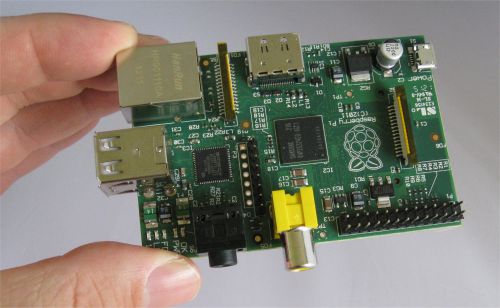
Pete W:
So RSComponents.com – we've got our Pi store there, so if you're a business user, you can get through your usual RS account, or there's a Pi store for regular consumers. All the accessories are on there too. If you're a complete newbie to all of this, you can buy a pre-programmed operating system on a card, or if you're feeling a bit more adventurous, which is what the Pi was designed for, go and take down the operating system yourself, and image it on to the card; get started. That's the great thing about the Raspberry Pi – it's generally not an out-of-the-box experience, and this is what it's all about. Although they've made a new operating system now called NOOBS, which has come out recently, which makes it easy for somebody who's not into this at all to get started, I encourage people who are a little bit more savvy to go down the nostalgia route, rip down the OS, copy or image it onto the SD card yourself, get to the command line, start typing in your code, and off you go.
The Raspberry Pi, by the way, was called Raspberry Pi A, because raspberry's the reference to the fruit that around – BlackBerry, Apple, that kind of stuff; Pi stands for Python, which is the programming language of choice. So get into it, get your kids into it. I'm doing an event next week with a bunch of mums up in London, to try and get them into learning about Pis. They're so simple – in effect, anybody can use them. You can be as simple or as complicated as you like.
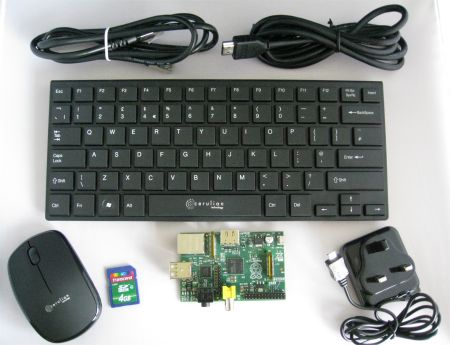
Pete:
And one Pete to another – thank you very much for selling me the Pi – Pi, not Py, of course. Just remind us again of the web address there?
Pete W: So it's RSComponents.com.
Transcript continues: Leap Motion Controller
Listen to FrequencyCast Show 91 - Raspberry Pi Interview |
More information: